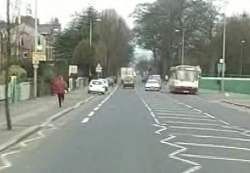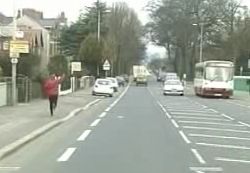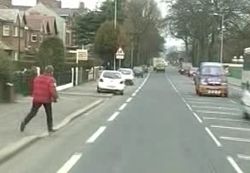The Hazard Perception Test
The hazard perception test begins once you have finished the multiple-choice section of the theory test.
As a video clip showing a road traffic situation plays, you must identify a developing hazard:
something that will cause the driver to change speed, direction, or stop.
When you see the hazard develop, click the mouse. The sooner you click, the more points you score. Five points are the maximum per hazard. Click too late, and you score zero.
There are fourteen clips. Thirteen show one hazard, and one shows two.
You cannot continuously click the mouse as the clip plays. If you do this, you will score zero. However, you will not lose points for clicking on other potential hazards that may also appear. The practice clips below will familiarize you with this.
To Pass The Hazard Perception Test
As soon as you see a potential hazard forming, click the mouse, briefly pause, then click again. The hazard may not develop into an actual hazard, but because you clicked, you have covered yourself if it does.
- A video clip of a road traffic situation plays.
- Several potential hazards will emerge, but most will not develop into actual hazards.
- As soon as you see a potential hazard, click the mouse once, pause, then click again.
- If the potential hazard continues to develop into an actual hazard, click again.
- One or two potential hazards will develop into actual hazards that force the driver of the car to slow down, change direction or stop. To score points, you will need to identify them.
- If you click too many times, you will score zero.

Potential Hazard
The woman is running along the pavement. Does she want to catch the bus? Does she intend to hurry across the road? Maybe, but if you click now you won’t score any points, as she is not an actual hazard only a potential one.

Developing Hazard
The woman is running along the pavement. Does she want to catch the bus? Does she intend to hurry across the road? Maybe. But if you click now, you won’t score any points, as she is not an actual hazard, only a potential one.

Actual Hazard
The woman is on the road and has become an actual hazard. She has forced the driver to take action: to change speed, direction, or stop. The scoring window closes just before this action begins. If you click now, you will score nil points.
To Pass The Test
To pass the test, you must score at least 44 points out of a possible 75 points, and you must also pass the theory test, multiple-choice questions, which you will take before starting the hazard perception.
The Test Is Taken
The test is the second part of the driving theory test. After you complete the theory multiple-choice questions, you will be permitted a break of up to 3 minutes. A short tutorial video explaining how the test works will then play. Once the video finishes, the test will begin. The test will last for around 20 minutes.
Definition of a Hazard
A road traffic hazard can be anything that causes a driver to change the speed, the direction, or stop the vehicle they are driving. Although real-life hazards may be static, such as a set of traffic lights, a junction, or a bend, these are not the hazards you will need to identify during the hazard perception test.
During the test, you will need to identify hazards that develop, and so have motion, such as a bus pulling away from a bus stop or a lollypop lady stepping into the road.
Too many Clicks?
If you click the mouse too many times while taking the test, you will score zero for the clip.
How many are too many?
The DVSA does not reveal this. However, as they say, do the maths. Each hazard test is about one minute long. If you clicked once every two seconds (about thirty clicks in total) you would definitely click at least twice on the actual hazard while the scoring window was open, as the scoring window must be at least five seconds long. So, from this, can we conclude thirty clicks would be too many?
Potential Hazards
When driving a car, hazards can come from all directions and emerge from most road traffic situations. As learner drivers taking practical lessons with a driving instructor, you will encounter such hazards regularly. In doing so, you will learn a great deal about taking and passing the hazard test.
Think of the driving test as a single entity – not three separate tests. Practicing for the hazard perception test will help you pass the practical test and vice-versa.
Below is a list of road traffic hazards you will experience while driving. These hazards will appear in the hazard test as potential and actual hazards. When taking the test, if you see any of these potential hazards or situations, you should ask yourself how they, as potential hazards, may turn into actual hazards. Always be thinking, ‘what if?’
General Driving
- Road traffic signs. Does the sign relate to a hazard ahead?
- Pedestrians: walkers, people with walking sticks. Will the pedestrian suddenly enter the road and become an actual hazard? Are they looking into the road, as if getting ready to cross? Do they need to cross the road to get to a bus or to something else?
- Children playing. Are they playing with something, a ball perhaps, that they may chase into the road?
- Cyclists and motorbikes, especially young cyclists. Is there a right turn ahead? If so, will they pull out into the centre of the road in order to take it? Are there obstacles on the left side of the road, such as parked cars or drain covers, that may force the cyclist to swerve right into the road and become a hazard to following traffic?
- Emergency vehicles. Is the vehicle moving towards you? Will you have to stop to let is pass? Will vehicles around you stop or slow down, thus causing you to take action?
- Blind bends. Could a large vehicle be coming the other way?
- Road lanes. Will a vehicle suddenly change lanes and cause you to take action? Can you see indicator lights flashing? Does another driver want to turn into your lane?
- Brake lights on vehicles. Is traffic ahead responding to a hazard that you can’t yet see?
Residential Streets
Residential streets are full of potential hazards as they contain not just moving road traffic but pedestrians, cyclists, and parked vehicles restricting views and movement. Look out for:
- Cars pulling out suddenly. Is there a pedestrian hurrying to get into a parked car? If so, once in the car, will they pull away into your path without looking properly?
- Children playing near the road. Do parked cars conceal the children? If so, an actual hazard could quickly develop.
- Vehicles pulling out of side roads, especially those vehicles with restricted views. If a car speeds towards a side road junction, is the driver more likely to emerge from the junction too quickly and so become a hazard?
- Pedestrians crossing roads. A pedestrian running while looking to cross a road may take a risk and become a hazard. can you see a pedestrian edging towards the road as they walk? Will they start to cross without looking?
- Cars stopping to park. Where there are few available parking spaces, drivers may brake sharply when they see a space.
- Oncoming traffic not giving you priority. If an obstacle on the opposite side of the road restricts traffic flow on-coming traffic should give you priority and let you pass. But will they?
Roads Near Schools
There is always a good chance that the hazard test will include a hazard by a school, as the powers that be, quite rightly, like to highlight the safety of children on our roads. Look out for:
- Children playing near the road, especially ball games.
- Children running, as they may run suddenly into the road.
- Children crossing the road without looking.
- Crossing patrols and other forms of crossings. A ‘lollipop’ lady may step into the road without due warning.
- Children cycling on pavements. May they swerve into the road?
- Ice cream vans that children may walk out from behind.
Country Roads
If you are a learner driver who lives in a city or large town, it may be that you will never have a driving lesson on a rural road. This unfamiliarity with rural driving increases the likelihood that a rural hazard will appear in the hazard perception test, as the DVSA wants to prepare you for the day you do drive on a rural road. Look out for:
- Single lane roads. What could be coming the other way?
- Slow moving vehicles, such as tractors. Always treat them as a hazard.
- Animals, especially horses and riders, cows and sheep. Are they in the road, and will they cause you to slow down or stop?
- Blind bends. The blocked view ahead could hide all sorts of hazards.
- Objects in the road especially manure, mud, hay and water, that may cause a vehicle to swerve.
- People walking against the flow of traffic.
Motorway Hazards
- Cars breaking down on the carriageway.
- Exit roads. Cars may pull across lanes to reach an exit and so become a hazard.
- Cars changing lanes to overtake slower moving traffic.
- Cars joining the motorway. Will they pull in too early and become a hazard?
- Emergency vehicles.
- Stationary traffic.
- Road works.
Preparing For The Test
To prepare and practice for the hazard perception test, try testing yourself. Take a journey by car and watch the road ahead. Numerous hazards will emerge. Some will develop, and others will not. Can you tell which?
For the potential hazards that develop into actual hazards, ask yourself what action you would need to take to deal with them safely. Of course, the driving lessons you take in a car will give you a good insight into how potential hazards develop into actual hazards.
